| dc.contributor.author | Purcell, Oliver | |
| dc.contributor.author | Wang, Jerry S. | |
| dc.contributor.author | Siuti, Piro | |
| dc.contributor.author | Lu, Timothy K | |
| dc.date.accessioned | 2019-03-25T17:17:51Z | |
| dc.date.available | 2019-03-25T17:17:51Z | |
| dc.date.issued | 2018-11 | |
| dc.identifier.issn | 2041-1723 | |
| dc.identifier.uri | http://hdl.handle.net/1721.1/121080 | |
| dc.description.abstract | Synthetic biologists use artificial gene circuits to control and engineer living cells. As engineered cells become increasingly commercialized, it will be desirable to protect the intellectual property contained in these circuits. Here, we introduce strategies to hide the design of synthetic gene circuits, making it more difficult for an unauthorized third party to determine circuit structure and function. We present two different approaches: the first uses encryption by overlapping uni-directional recombinase sites to scramble circuit topology and the second uses steganography by adding genes and interconnections to obscure circuit topology. We also discuss a third approach: to use synthetic genetic codes to mask the function of synthetic circuits. For each approach, we discuss relative strengths, weaknesses, and practicality of implementation, with the goal to inspire further research into this important and emerging area. | en_US |
| dc.description.sponsorship | United States. Defense Advanced Research Projects Agency (MK01 cell) | en_US |
| dc.description.sponsorship | United States. Defense Advanced Research Projects Agency (MK02 cell) | en_US |
| dc.publisher | Nature Publishing Group | en_US |
| dc.relation.isversionof | http://dx.doi.org/10.1038/s41467-018-07144-7 | en_US |
| dc.rights | Creative Commons Attribution 4.0 International license | en_US |
| dc.rights.uri | https://creativecommons.org/licenses/by/4.0/ | en_US |
| dc.source | Nature | en_US |
| dc.title | Encryption and steganography of synthetic gene circuits | en_US |
| dc.type | Article | en_US |
| dc.identifier.citation | Purcell, Oliver, Jerry Wang, Piro Siuti, and Timothy K. Lu. “Encryption and Steganography of Synthetic Gene Circuits.” Nature Communications 9, no. 1 (November 22, 2018). | en_US |
| dc.contributor.department | Institute for Medical Engineering and Science | en_US |
| dc.contributor.department | Massachusetts Institute of Technology. Department of Biological Engineering | en_US |
| dc.contributor.department | Massachusetts Institute of Technology. Department of Electrical Engineering and Computer Science | en_US |
| dc.contributor.department | Massachusetts Institute of Technology. Department of Nuclear Science and Engineering | en_US |
| dc.contributor.department | Massachusetts Institute of Technology. Research Laboratory of Electronics | en_US |
| dc.contributor.mitauthor | Purcell, Oliver | |
| dc.contributor.mitauthor | Wang, Jerry S. | |
| dc.contributor.mitauthor | Siuti, Piro | |
| dc.contributor.mitauthor | Lu, Timothy K | |
| dc.relation.journal | Nature Communications | en_US |
| dc.eprint.version | Final published version | en_US |
| dc.type.uri | http://purl.org/eprint/type/JournalArticle | en_US |
| eprint.status | http://purl.org/eprint/status/PeerReviewed | en_US |
| dc.date.updated | 2019-03-04T13:28:49Z | |
| dspace.orderedauthors | Purcell, Oliver; Wang, Jerry; Siuti, Piro; Lu, Timothy K. | en_US |
| dspace.embargo.terms | N | en_US |
| dc.identifier.orcid | https://orcid.org/0000-0002-2031-8871 | |
| dc.identifier.orcid | https://orcid.org/0000-0002-9999-6690 | |
| mit.license | PUBLISHER_CC | en_US |
